Driving into the field and seeing this drill travelling up and down what seemed to be a perfectly good and heavy crop of grass was completely alien to me but by the time I had left it seemed no different than any other crop establishment system. It was just a different way of going about it.
Jonny Greene was sowing winter wheat into the grass field which had been sprayed off just two days prior to the start of drilling. The plan was that the wheat will appear through the dying-off grass and the dead grass will keep control of the weed pressure as the crop is forming its own canopy.
Jonny believes that ground should never be left bare as weeds will grow where land is idle and thinking about this it makes sense.
The Greenes converted to non-inversion tillage in the late 1990s and a plough was last used in 2001. Since then, he has moved from min-till to strip-till and now to no-till.
The drill that is now the mainstay of this system is an interesting piece of kit. The New Zealand-built Cross Slot is the only one of its kind to be working on the island of Ireland; there are some working in the UK, but not on a serious scale. The drill was bought in 2015 and has completed two full seasons on the Greene’s farm, with a main cropping acreage of around 800ac per year.
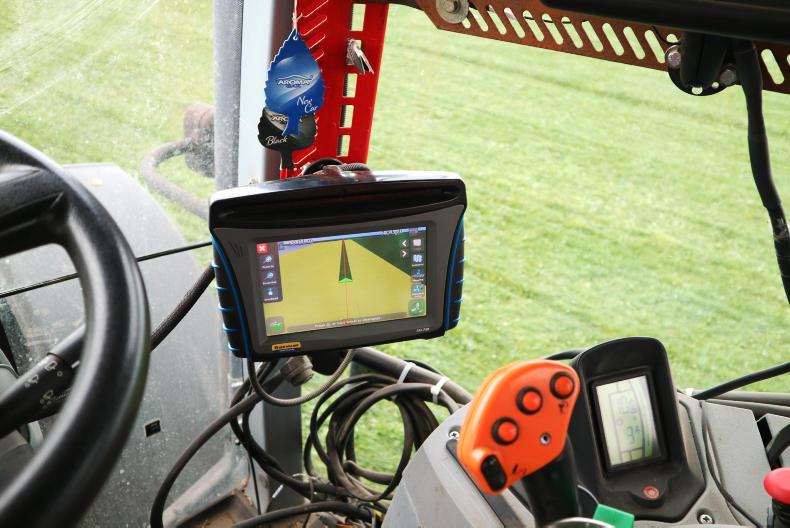
This in conjunction with cover crop establishment on large areas means that this 3m machine is getting through some serious work.
The drill was imported directly from New Zealand and was built to the Greenes’ personal specification.
Jonny has tried or researched every option available to him and the Cross Slot fitted the bill.
The drill
Looking at the drill, you can see the engineering that has gone into this machine. The weight of the frame is the first thing that struck me. This allows for the discs to apply the pressure required to penetrate the ground, even when set at some serious pressure. This pressure is set from the cab of the tractor and ensures that the discs get to the desired depth.
The depth of each disc is set independently with a lockable turnbuckle on each opener leg. When I was there, the drill was set to sow at 1.5in in order to get it below the mat of grass roots that may become toxic when the sward begins to die off.
The row spacing on this machine is 8in so there are 15 disc assemblies across this 3m machine. Each of these openers consists of a disc and one or two blades depending on whether seed and fertiliser are being placed or just seed.
The best way to see how this works is in the logo the company uses. It opens up a slot that surprising enough is in the shape of a cross. Due to this shape of opening, the seed is left in a nice environment to get started. All this design comes from the fact that founders of the company behind this machine, Baker No-Tillage Ltd, were formerly scientists and engineers at New Zealand’s Massey University and invented the Cross Slot no-tillage technologies over a 30-year period.
Travelling up and down the field on the tractor, I could see the design that had gone into this machine. It worked very well while sowing into the clover and grass sward. When I inspected the ground, the drill was doing such a good job of closing the slots that it was difficult to find them.
When we did find one and opened it, we could see the seed left in the side of the slot with plenty of loose soil around it. To look at the drill you would think that it would be very hard to pull but according to the manufacturers it takes about 10-12hp to pull each opener. So with 15 openers, the power requirement should be a mere 150-180hp. Jonny is running the drill on a New Holland T7050 which produces around 195hp. This is more than enough for Jonny to sow at whatever speed he needs to.
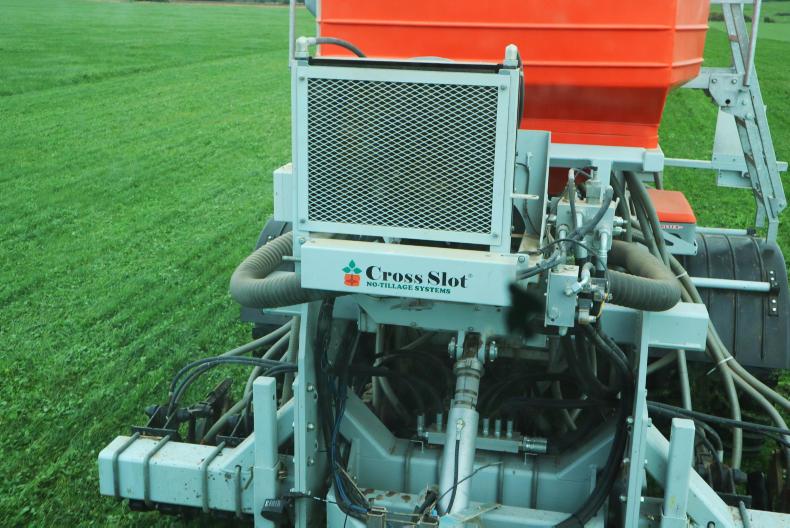
Traveling at greater forward speed can lead to greater soil disturbance, which can lead to more weeds. A speed of between 8km/h and 12km/h is the range of working speeds depending on the ground conditions.
The rate is controlled using the well-known and always accurate Accord-type metering system; this can be adjusted from the cab. Jonny has found that this system works well for him.
The tractor is guided using a Trimble/New Holland aftermarket auto steer system. Linked to the RTX signal this gives the tractor down to 1.5in of accuracy, more than good enough when you are working with 8in between rows.
The Cross Slot has the capability to place both seed and fertiliser at the same time. The 1,200-litre seed hopper holds 1t of seed comfortably and the 2,500-litre fertiliser hopper hold 2t at its ease. As I said earlier, this is a solidly built machine and weighs in at 6.5t with no seed or fertiliser on board.
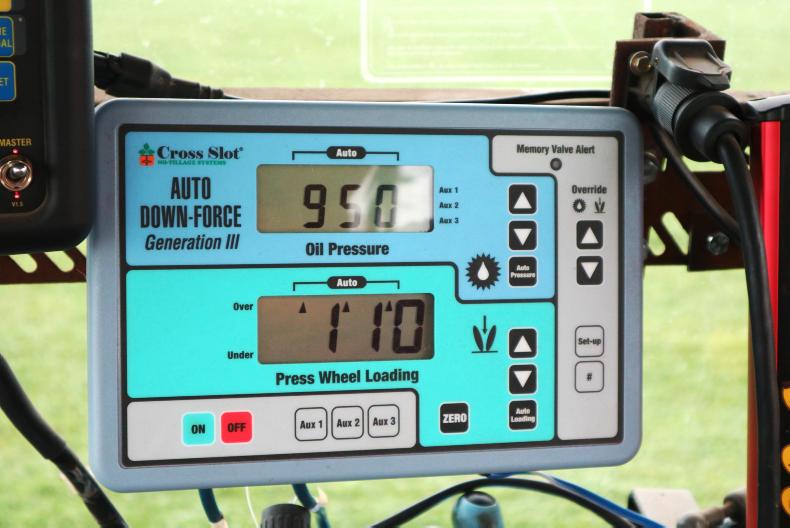
Savings and advantages
Since the drill has arrived, the labour requirement on the farm has dropped by one unit and also the farm can now be operated using one less tractor unit. This was easily seen by looking over the hedge where “conventional tillage” was taking place and there were three tractors involved with a plough, combination drill and roller being used to get the crop in the ground.
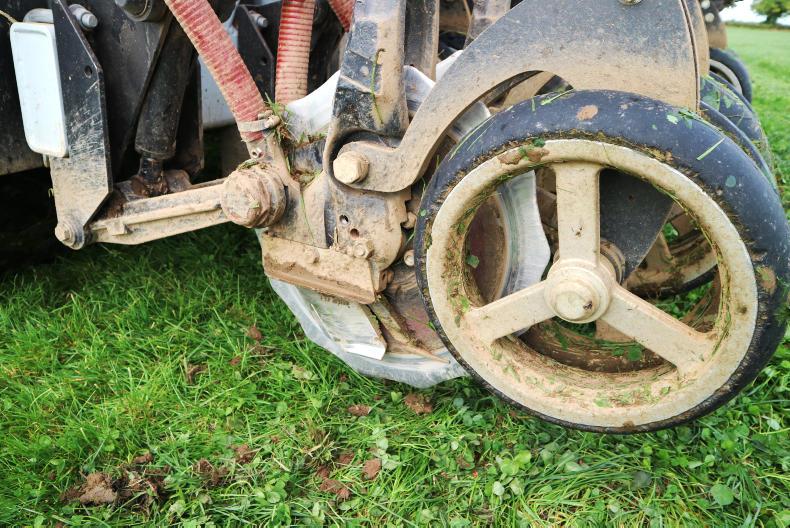
Jonny believes that there are massive savings in both labour and the kit that is needed with his system but his main reason for this system is the fact that it minds what he believes is his most precious asset, the soil. Over the two seasons that the machine has been in use, the tractor has used approximately four to five litres of fuel per acre, very low in comparison to the conventional system.
The two wearing parts on the drill are the discs and the blades that open the slot. The discs need to be replaced every 750 acres. When this is calculated in euro per acre, it costs approximately €1/ac. The knives have a service interval of 1,000 acres. When calculated back, this give costs of €1.40/acre. These figures make for good reading and seem to make this a low-cost method of crop establishment in comparison to all other systems.
Verdict
This system is very impressive when operated with the level of skill and professionalism that the Greenes bring to it. They can show that it is working for them as the two years of yield with this drill and system are above their five-year averages. When I asked Jonny if the drill was the most important part of the system, his answer was “no, the spade was”.
This shows that it takes serious attention to detail for no-till to work but when the skills are present this drill is an amazing piece of kit.
Once I had gotten over the alien feeling of sowing of wheat into a perfectly good field of grass, I could see that this drill allows this farm to cover large acres without over working the soil and damaging their most important asset at the same time as reducing costs and labour requirement on the farm.
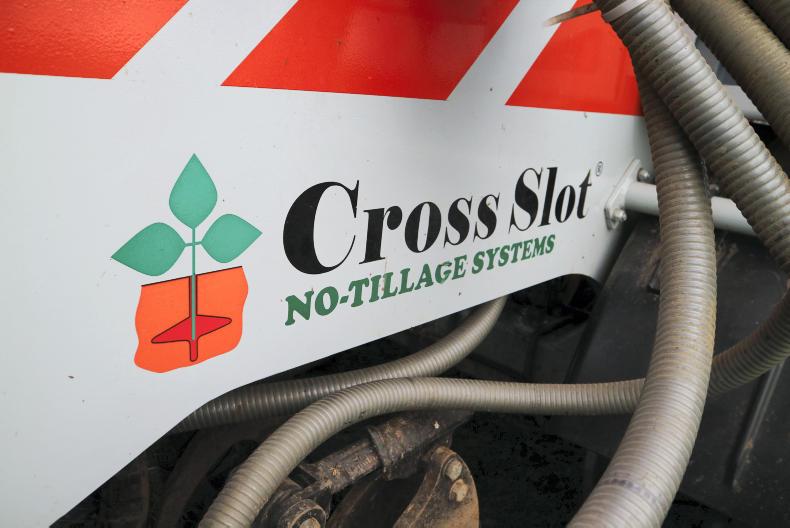
Read more
Watch: organic spreads and comfy cows beds with straw blower
Trelleborg makes tracks with tyres
Driving into the field and seeing this drill travelling up and down what seemed to be a perfectly good and heavy crop of grass was completely alien to me but by the time I had left it seemed no different than any other crop establishment system. It was just a different way of going about it.
Jonny Greene was sowing winter wheat into the grass field which had been sprayed off just two days prior to the start of drilling. The plan was that the wheat will appear through the dying-off grass and the dead grass will keep control of the weed pressure as the crop is forming its own canopy.
Jonny believes that ground should never be left bare as weeds will grow where land is idle and thinking about this it makes sense.
The Greenes converted to non-inversion tillage in the late 1990s and a plough was last used in 2001. Since then, he has moved from min-till to strip-till and now to no-till.
The drill that is now the mainstay of this system is an interesting piece of kit. The New Zealand-built Cross Slot is the only one of its kind to be working on the island of Ireland; there are some working in the UK, but not on a serious scale. The drill was bought in 2015 and has completed two full seasons on the Greene’s farm, with a main cropping acreage of around 800ac per year.

This in conjunction with cover crop establishment on large areas means that this 3m machine is getting through some serious work.
The drill was imported directly from New Zealand and was built to the Greenes’ personal specification.
Jonny has tried or researched every option available to him and the Cross Slot fitted the bill.
The drill
Looking at the drill, you can see the engineering that has gone into this machine. The weight of the frame is the first thing that struck me. This allows for the discs to apply the pressure required to penetrate the ground, even when set at some serious pressure. This pressure is set from the cab of the tractor and ensures that the discs get to the desired depth.
The depth of each disc is set independently with a lockable turnbuckle on each opener leg. When I was there, the drill was set to sow at 1.5in in order to get it below the mat of grass roots that may become toxic when the sward begins to die off.
The row spacing on this machine is 8in so there are 15 disc assemblies across this 3m machine. Each of these openers consists of a disc and one or two blades depending on whether seed and fertiliser are being placed or just seed.
The best way to see how this works is in the logo the company uses. It opens up a slot that surprising enough is in the shape of a cross. Due to this shape of opening, the seed is left in a nice environment to get started. All this design comes from the fact that founders of the company behind this machine, Baker No-Tillage Ltd, were formerly scientists and engineers at New Zealand’s Massey University and invented the Cross Slot no-tillage technologies over a 30-year period.
Travelling up and down the field on the tractor, I could see the design that had gone into this machine. It worked very well while sowing into the clover and grass sward. When I inspected the ground, the drill was doing such a good job of closing the slots that it was difficult to find them.
When we did find one and opened it, we could see the seed left in the side of the slot with plenty of loose soil around it. To look at the drill you would think that it would be very hard to pull but according to the manufacturers it takes about 10-12hp to pull each opener. So with 15 openers, the power requirement should be a mere 150-180hp. Jonny is running the drill on a New Holland T7050 which produces around 195hp. This is more than enough for Jonny to sow at whatever speed he needs to.

Traveling at greater forward speed can lead to greater soil disturbance, which can lead to more weeds. A speed of between 8km/h and 12km/h is the range of working speeds depending on the ground conditions.
The rate is controlled using the well-known and always accurate Accord-type metering system; this can be adjusted from the cab. Jonny has found that this system works well for him.
The tractor is guided using a Trimble/New Holland aftermarket auto steer system. Linked to the RTX signal this gives the tractor down to 1.5in of accuracy, more than good enough when you are working with 8in between rows.
The Cross Slot has the capability to place both seed and fertiliser at the same time. The 1,200-litre seed hopper holds 1t of seed comfortably and the 2,500-litre fertiliser hopper hold 2t at its ease. As I said earlier, this is a solidly built machine and weighs in at 6.5t with no seed or fertiliser on board.

Savings and advantages
Since the drill has arrived, the labour requirement on the farm has dropped by one unit and also the farm can now be operated using one less tractor unit. This was easily seen by looking over the hedge where “conventional tillage” was taking place and there were three tractors involved with a plough, combination drill and roller being used to get the crop in the ground.

Jonny believes that there are massive savings in both labour and the kit that is needed with his system but his main reason for this system is the fact that it minds what he believes is his most precious asset, the soil. Over the two seasons that the machine has been in use, the tractor has used approximately four to five litres of fuel per acre, very low in comparison to the conventional system.
The two wearing parts on the drill are the discs and the blades that open the slot. The discs need to be replaced every 750 acres. When this is calculated in euro per acre, it costs approximately €1/ac. The knives have a service interval of 1,000 acres. When calculated back, this give costs of €1.40/acre. These figures make for good reading and seem to make this a low-cost method of crop establishment in comparison to all other systems.
Verdict
This system is very impressive when operated with the level of skill and professionalism that the Greenes bring to it. They can show that it is working for them as the two years of yield with this drill and system are above their five-year averages. When I asked Jonny if the drill was the most important part of the system, his answer was “no, the spade was”.
This shows that it takes serious attention to detail for no-till to work but when the skills are present this drill is an amazing piece of kit.
Once I had gotten over the alien feeling of sowing of wheat into a perfectly good field of grass, I could see that this drill allows this farm to cover large acres without over working the soil and damaging their most important asset at the same time as reducing costs and labour requirement on the farm.

Read more
Watch: organic spreads and comfy cows beds with straw blower
Trelleborg makes tracks with tyres






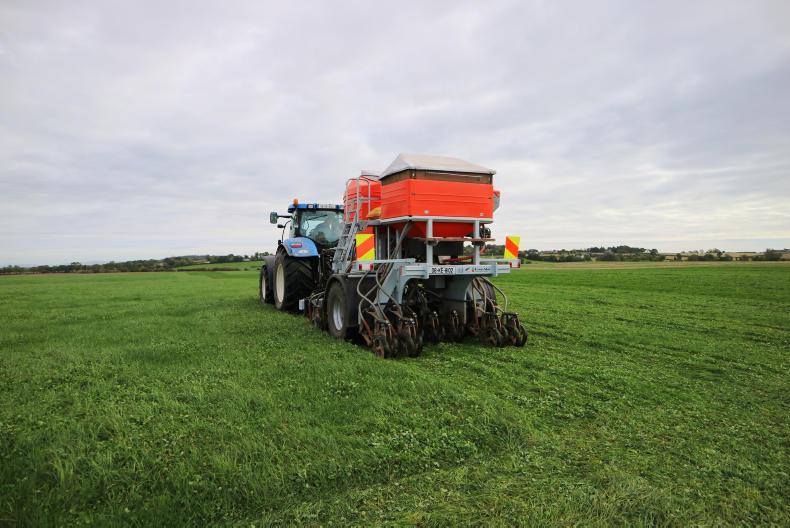




 This is a subscriber-only article
This is a subscriber-only article














SHARING OPTIONS: